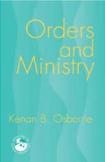The Struggle Continues
This volume is crammed with meticulously researched biblical, historical, theological and sociological information on order and ministry in the Catholic Church. The author, Kenan Osborne, O.F.M., is professor emeritus at the Franciscan School of Theology in Berkeley, Calif., and the author of several distinguished books. Evidence of his extensive scholarly career and his commitment to recognize the church as a global institution fills the pages of Orders and Ministry.
The book weaves together the following major themes: the meanings and implications of globalization, the ministry of Jesus as the foundational model for all ministries and the history and meaning today both of priestly order and ministry and of lay ministry. In the concluding chapter Osborne suggests creative ways for the Roman Catholic Church to continue to develop “an equicultural order and ministry” that takes into account a global perspective. The goal of his work is to understand leadership in a global church, in which some dynamics of ministry are linked to the essence of Christian life and other elements need to change. Each chapter concludes with questions suitable for adult education and classroom discussion and with well-chosen suggestions for further reading and study.
The first chapter, on globalization, provides an overview of the meanings of this term in society generally and of parallel implications for the church specifically. The profound impact of globalization on local cultures requires proper adaptation at a time when the struggle is ardent between “conservers” and “innovators.” Concerning the role of the church, Father Osborne states, “In ‘new churches’ particularly in Africa and Asia, Christianity thrives, but some believe the life of these churches will deepen if inculturation is allowed to use local languages, rituals, and traditions.” Still others, he notes, believe that the radical challenge of Christ will be lost with too much adaptation. Though issues are complex, he acknowledges his own inclination toward change to culturally appropriate forms of leadership, order and ministry.
An extensive chapter on the “Ministry of Jesus” sets the foundation for the remainder of the book. After establishing the leadership of Jesus as service, he describes in detail key developments in early church ministry, showing that ministerial roles in culturally different communities evolved over time. The author points out controversies that arose, especially over the shape of liturgical rites and whether ordained ministries could differ widely from place to place. Acknowledging that many adaptations have been implemented already, he asserts that more should be contemplated. The Gospels do not provide “how-to lessons on the best way to minister,” nor do they offer solutions to specific problems. Rather, they look at “the ministry of Jesus to see how Jesus opened others to the loving and forgiving presence of God.”
When ministry deviates from this understanding, questions need to be asked and issues raised, which Osborne does with a delicate balance of prudence and challenge. He prefaces the most difficult issues with such expressions as “although it is painful to raise the next question” or “we are advancing a position here that recognizes the affection of many for the present order of the church.” Nonetheless, he asks the hard questions and raises thorny issues. He contrasts, for example, the call of many bishops at the Second Vatican Council to make liturgy meaningful in different cultures with Rome’s deafness toward local and regional voices and opinions on the translation of Mass prayers.
Osborne acknowledges and discusses the controverted role of women in the church. Addressing the basic theme of the book, he writes, “It is clear that some Catholic scholars maintain the view that order and ministry are immutably defined. Nevertheless, both the New Testament and documents from the early history of the church indicate that there has been considerable change in names and functions in ministry.”
On the model of the priesthood and the episcopacy, the author states plainly that the present pattern is not only desired by Rome, but mandated. Given this position, it is difficult for historians and theologians to speak and write freely on what their research tells them about the factual basis for this portrayal. While the author acknowledges there is no large groundswell demanding change, theological and missiological reasons for considering change are critical in a global church. One size does not fit all when looking at church leadership.
As to lay ministry, Osborne focuses on both institutional and charismatic leadership. He briefly articulates the distinct historical differences in the way lay members have exercised teaching, liturgical and administrative ministries, and also comments on the official post-Vatican II theological position of the church on lay ministry. He holds that paying attention to the sensus fidelium of local situations is the best way to determine the most appropriate forms of leadership.
The final chapter captures Osborne’s “Dreams for the Future.” He insists on the integrity of all cultures, which are to be honored and treated with reverence. He asks that the dialogue between church and culture be two-directional. As local churches evolve, he is adamant that the marks of the true church of Christ be given careful attention and that self-giving love be seen as the hallmark of the Christian ethos. Leadership and community deserve serious study, too, not just in the newer churches but in the church in Europe, where so many people no longer both believe and belong. In the end, Father Osborne reiterates a familiar theme: the reality of communion entails dialogue, and this view implies the need to consider major structural changes in the church.
Orders and Ministry is likely to challenge, incense or gratify, depending on where one stands on these vital ecclesiological concerns in the church today.
This article also appeared in print, under the headline “The Struggle Continues,” in the July 17, 2006, issue.








